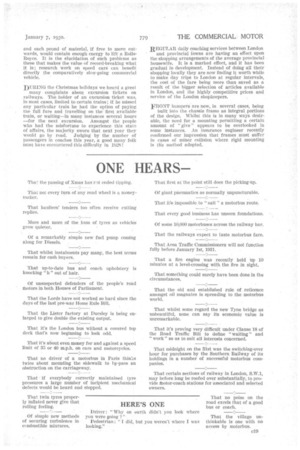LOOSE LEAVES
Page 40

Page 41

If you've noticed an error in this article please click here to report it so we can fix it.
WHEN one hears that tram-rail factories are closing down owing to lack of orders, one does feel that the doom of the tramcar is inevitable, however long such an event may be delayed. The latest works of this kind to be affected by the expanding incursions of the road motor are at Duisburg, Germany.
Such occurrences do certainly suggest that the attitude of passenger-transport officials is steadily veering in favour of the motorbus and motor coach. Moreover, this policy is not insular in character, but has a decidedly international cloak.
AT long last the inland town tax on petrol carried for use on motors entering or leaving Paris has been abolished, and motorists journeying to and from the French capital will welcome the removal of a source of much irritation. Protracted periods of waiting have often been necessary while receiving or returning the green slip on which the amount of petrol being carried was declared—or supposed to be declared !
TWO interesting points occurre3 in the paper of Mr. W. Lewis Morgan, recently read before the members of the I.A.E. at Bristol. One concerned • the use of pneumatic tyres. By changing intern c18 gently the positions of the tyres and keeping the new covers on the front wheels, he estimates that delays on
the roads, due to tyre failure, should not exceed one per 150,000 to 250,000 vehicle-miles run under normal conditions. The second point concerned the possibilitY of fabriccovered bodies for public-service vehicles as a means for modifying the refinishing process. In his opinion, it would be possible to effect a complete renovation of the outside of a vehicle in one day if this form of construction were adopted.
SO much interest is being displayed now in the development of the pneumatic tyre that we need no further excuse for referring to the types which are being made to stand up to speeds of between 200 and 300,11m.p.h.
In a single tyre revolving at a speed equivalent to 300 m.p.h. the centrifugal force is so great that it becomes one inch larger in diameter. When actually in use it will consume 3,792,000 ft.-lb. of energy every minute—enough power to lift a heavy express train one foot from the ground.
At such a speed the four tyres will absorb more than 200 h.p., and their temperature will increase to that of the boiling point of water in about 15 seconds. The tearing-apart effort is some 29,000 lb.,
and each pound of material, if free to move outwards, would contain enough energy to lift a RollsRoyce. It is the elucidation of such problems as these that Makes the value of record-breaking what it is; research work on speed cars can benefit directly the comparatively slow-going commercial vehicle.
DURING the Christmas holidays we heard a great
• many complaints about excursion tickets on .railways. The holder of an excursionticket was, in most cases, limited to certain trains; if he missed any particular train he had the option of paying the full fare and • travelling on the first available train, or waiting—in many instances several hours —for the next excursion. Amongst the people who had the misfortune to experience this state of affairs, the majority swore that next year they would go by road. Judging by the number of passengers in coaches this year, a good many folk must have encountered this difficulty in 1928!
REGULAR daily coaching services between London and provincial fowns are havingan effect upon the shopping arrangements of the average provincial housewife. It is a marked effect, and it has been gradual in development. Instead of doing all their shopping locally they are now finding it worth while to make day trips to London at regular intervals, the cost of the fare being more than saved as a result of the bigger selection of articles available in London, and the highly competitive prices and service of the London shopkeepers.
FRONT bumpers are now, in several cases, being built into the chassis frame as integral portions of the design. Whilst this is in many ways desirable, the need for a mounting permitting a certain amount of " give" appears to be overlooked in some instances. An insurance engineer recently confirmed our impression that frames Must suffer in cases of minor collision where rigid mounting is the method adopted.












































































































